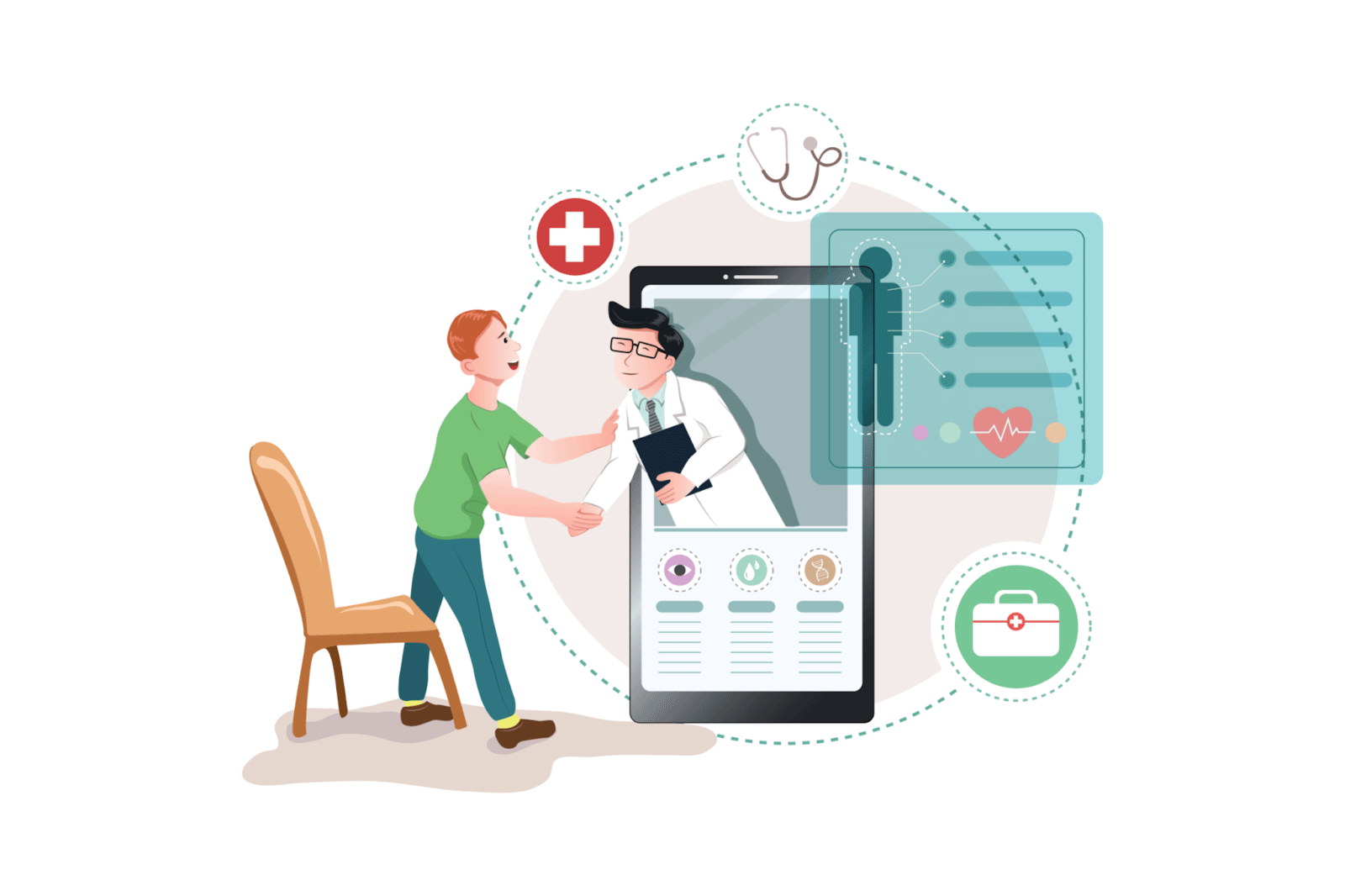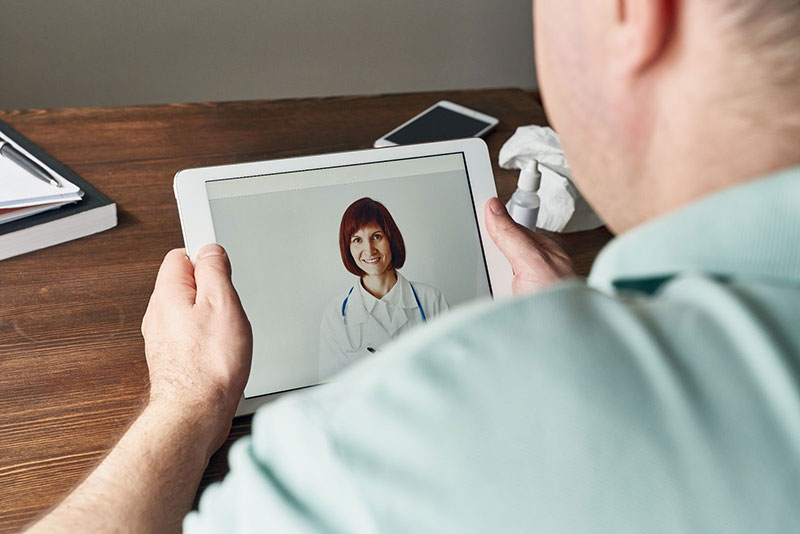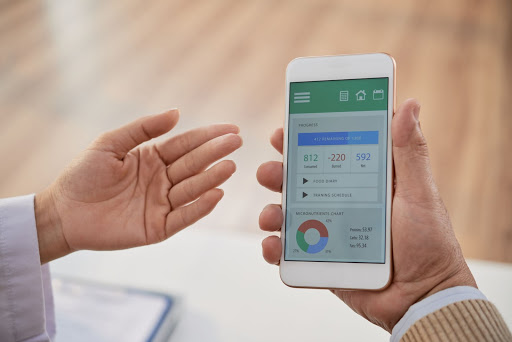Establishing Doctor-Patient Relationships in Telemedicine
Is it possible to put a date on when all of our communication moved from phone or face-to-face to texting, social media, and avatars? Our digital communication technology has definitely reached Twilight Zone levels of scary. But let’s step back and look at all the amazing things these technological advances have helped us accomplish.

We can keep in touch with relatives across the globe, we can make new friends just by having the same interests on our social profiles, and–the part that’s applicable to today’s topic–we can even take care of our health through telemedicine apps and systems. But there never will be a complete replacement for the value of in-person relationships.
In the medical field, this is especially true, and a common point of discussion among providers. How do we maintain doctor-patient relationships in a world where our patients would prefer to Google what causes their symptoms (and we all know what those search results look like), than actually talk to their doctors?
While you know that you carefully weigh all options to make the best decisions for your patients, patients and providers are not always on the same page. The biggest reason simply comes down to trust.
Even when just thinking about seeing a doctor, there are psychological factors at play for patients. They might not even notice the effect, like when white coat syndrome gives them high blood pressure readings just for being in a medical setting. On the other hand, patients can also make conscious decisions that can not only jeopardize the rapport between doctor and patient but can also harm their own health.
So how do we address patient concerns through telemedicine, maintain and build relationships with patients virtually, and build enough trust with them that they’ll choose our cultivated knowledge over the all-powerful Google?
The first step is in truly understanding the patient’s perspective.
How Patients See It
The very term “doctor” implies intelligence, safety, and healing. When we think of doctors, we think of someone who can help us. Yet despite this, studies consistently report that up to 80% of people either keep relevant information from their doctors or even lie outright. It’s a baffling phenomenon, but curiously patients aren’t typically trying to purposefully mislead their doctors. There’s more going on beneath the skin here.
Some of the most common reported reasons patients may behave contrary to their best interest in a medical setting include:
- Fear of judgment
- Fear of embarrassment
- Avoidance of being lectured on behavior
- Concern over taking up the doctor’s time
Embarrassment and anxiety also fuel patient behaviors, like staying quiet when they may disagree with the doctor, not opening up when they don’t understand, and not asking clarifying questions.
But with telemedicine, there’s a unique opportunity to foster relationships between patients and providers that changes patient behavior tendencies. The distance and virtual connection may make patients more comfortable communicating with physicians, allowing them to get a better understanding of their health and be a more proactive participant.
Potential Obstacles of Telemedicine
That’s not to say that telemedicine is the perfect solution, however. Telemedicine is still in its infancy, so doctor-patient relationships are actually only one obstacle it faces right now.
Physical Care
It will never be possible to do every visit through telemedicine. While this is not really an obstacle that can be overcome, it’s important to note that time and resources devoted to telemedicine care and traditional health care should stay balanced.
Reliance on Technology
One of the biggest obstacles in telemedicine is the complete reliance on internet connections and technology. It’s particularly concerning for elderly patients who don’t have the technology available or aren’t too comfortable using it. Plus, connection problems on either end cause delays, which cost you time and money… and a bit of sanity.
Insurance
Depending on insurance, telehealth may not be covered equally or at all. If patients have multiple appointments or need to see a specialist, medical costs add up pretty quickly. If the price tag is too hefty, patients may cancel or not schedule necessary follow-ups. The same goes for uninsured patients who pay completely out-of-pocket. It goes without saying that canceling appointments can be a severe detriment to a patient’s health, but it’s worth mentioning again.
Security and HIPAA
With anything online or virtual, there is always the inevitable, and very real concern about security, privacy, and compliance. While sharing patient confidentiality online has its risks, and it is certainly a potential roadblock for telehealth tech, there is a strong case in its favor that it may actually make HIPAA compliance easier.
How Can Telehealth Help Doctor-Patient Relationships?
In other words, it’s not all bad news! Most of the potential drawbacks of telemedicine are also incredible opportunities. Sure, the internet may have connection issues, but overall it presents a tremendous opportunity for millions of people.
The Convenience of Technology
 The convenience of telemedicine is perfect for both providers and patients. The efficiency of virtual appointments saves time and money for both and is easier than dealing with traffic or patients who are running late. Plus, the rise of telemedicine brought the rise of home health monitoring devices, and remote patient monitoring systems are empowering, engaging, and protecting patients every day.
The convenience of telemedicine is perfect for both providers and patients. The efficiency of virtual appointments saves time and money for both and is easier than dealing with traffic or patients who are running late. Plus, the rise of telemedicine brought the rise of home health monitoring devices, and remote patient monitoring systems are empowering, engaging, and protecting patients every day.
Open Environment
Telehealth may help to improve open and honest communication. Patients are naturally going to be more comfortable in their own homes rather than sitting in an exam room, so they’ll already be more willing to open up. To encourage better communication, let patients know you expect them to ask questions and that no question is too simple. Use your best judgment based on the personality of each patient and remember to soften communication a bit when necessary.
Provider Demand
Experts predict a nationwide shortage of physicians by 2032 of up to over 55,000 primary care physicians and up to over 65,000 specialty care providers. Luckily, telehealth may be able to help prevent the shortage by offering a more streamlined workflow and better efficiency. Providers can see and treat more patients without sacrificing care or quality.
Insurance
Medicare and private insurance companies offer reimbursement for home health monitoring devices, making them lucrative for practices and much more affordable for patients. The tremendous improvement in patient outcomes makes remote patient monitoring insurance reimbursements a no brainer.
Patient-Centered Care
 Within the telehealth tech buffet, remote patient monitoring (RPM) provides perhaps the best opportunity for improving doctor-patient relationships, and is one of the most patient-centered care options available. RPM empowers patients and boosts confidence, not to mention improving patient outcomes and satisfaction.
Within the telehealth tech buffet, remote patient monitoring (RPM) provides perhaps the best opportunity for improving doctor-patient relationships, and is one of the most patient-centered care options available. RPM empowers patients and boosts confidence, not to mention improving patient outcomes and satisfaction.
When integrating an RPM solution, it’s important to find a system that is user-friendly for all parties involved: patients, doctors, and clinical staff. The more simple and intuitive the remote health monitoring system is, the more patients and staff are likely to use it. That seamless experience encourages communication between patients and doctors on a more frequent basis than in-person only appointments.
More communication means more understanding. And the more patients feel understood, the more they’ll trust you as their provider. If the platforms and systems themselves indicate a strong patient-centered care outlook on your practice, you’re one step closer to establishing that trust.
How Telemedicine Drives Patient Experience
Summing up, there’s no reason to worry about telemedicine taking a toll on relationships with your patients. Telemedicine provides the opportunity to increase trust between patient and provider and ultimately improves your patient relationships, especially with services like remote health monitoring.
Look at your telehealth services as an additional way to establish doctor-patient relationships, rather than an alternative way. Ideally, it’s just another tool in your belt that can and should be used to grow your patient relationships, and your practice. When handled in tandem, it provides you the opportunity to stay connected to your patients even when they aren’t visiting your office.
The patient experience and resulting relationship grows with:
- Two-way accountability between patient and provider
- Improved doctor-patient engagement
- Faster and more personalized access to care for patients
- 24/7 tech support for providers, staff, and patients
- Improved quality of care for patients
The incredible technology and features of remote patient monitoring help foster doctor-patient relationships and improve patient trust.